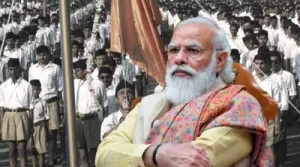(This article was published in India Today magazine on November 8, 2019. We are publishing it here for its continuing relevance – Eds.)
On the face of it, being Hindu in a ‘Hindu rashtra‘ might sound good to Hindu ears. You might think you are in a rashtra (nation) that is in sync with your faith, values and way of life. However, closer examination and some reflection on the nature of Hinduism as it is lived by hundreds of millions of Hindus will present a very different picture. To put it bluntly, for the sahaj Hindu, being Hindu in a Hindu rashtra is more likely going to be a nightmare. Etymologically, the word sahaj means something one is ‘born with’.
In usage, it connotes something done ‘with ease’, which is to say unburdened by diffidence or false pride, self-deprecation or arrogance. Hinduism, as it has grown organically over the centuries, is not a doctrinaire system. For sahaj Hindus, their faith and world view flow from epics like the Ramayana and the Mahabharata – in their myriad versions, none of them a simple translation from the classical Sanskrit, with their variations, texture and colour shaped by a million local stories – and the puranic narratives. The human agony, moral conflicts, anguished queries contained in these narratives – and the wisdom that follows their resolution – deeply impact the Hindu mind.
A sahaj Hindu learns from these lively narratives, not from abstract commandments. In these narratives, not even gods escape the logic of kaal (meaning: both time and death) and karma (both action and its consequences). After the fratricidal war of the Mahabharata, Krishna is cursed by a bitterly lamenting Gandhari for not having done enough to prevent the calamity. Krishna reminds Gandhari of her own indulgence of Duryodhana (her son), but he has to suffer her curse nonetheless, and witness a disastrous fratricidal conflict in his own Yadava clan. Folklore never spared Rama either for his deeply unjust treatment of Sita. Contrast this robust tradition of criticism, where even gods are fair game, with the proclivity among proponents of a Hindu rashtra to label dissenters as ‘anti-national’ heretics.
The Hindu tradition is inherently inclusive, so much so that its critics have often accused it of appropriating dissenting or breakaway traditions. The accusation stems from an inability to value Hinduism’s capacity to learn from criticism and to mainstream critical ideas – a capacity most vital for the longevity of a tradition. It’s this very civilisational genius for constant refinement that made someone wax lyrical in these famous words: Kuchh baat hai ki hasti mitati nahin hamari (It must be something about us that makes us indestructible)’.
Go look him up – he wrote what is easily the best known nazm celebrating the greatness of India. Another kind of mistrust of Hinduism has to do with the failure to see the distinction between so-called ‘Brahmanism’ and sahaj Hinduism or the lived reality of Hindus. The adherents of this prejudice believe that the gods of marginalised people have no place in the Hindu pantheon. That’s not true, though: to cite just one example, in the Chambal region of northern Madhya Pradesh, there are numerous little shrines and temples dedicated to Hira Bhumia, a 16th century folk hero of the Gujjar caste.
The story goes that Hira died trying to save a cow from a tiger. In the rainy season of bhado (August/ September), he is ritually invoked to ‘possess’ the most suitable devotee (often a Dalit/ OBC man) and through this devotee (called ghulla for this period) he is believed to heal all manner of ailments (snake bites are common) and resolve various crises in the life of the householder.
His grace makes no distinction between Hindu and Muslim, or between Dalit and Brahmin. So, those who think Hinduism has no spiritual or symbolic space for the marginalised are in the grip of a category mistake. The modern-day understanding of Hinduism has been done a great disservice by scholars who have reduced it to a 19th century construct as imagined by British scholars, census commissioners and their Indian assistants. This construct betrays its utter ignorance of vernacular sources.
Hinduism was a well-recognised religion/practice and Hindu an identity distinct from the geographical one centuries before the English reached Indian shores. Early modern poets like Vidyapati (1352-1448) and Kabir, Anantdas and Eknath (15-16th century) knew this well, as did European Christian missionaries like Giuseppe Maria da Gargnano (18th C.), who wrote tellingly about this in an imagined dialogue between a Christian missionary and a Hindu in the early 1750s.
Unfortunately, many contemporary scholars continue to perpetuate the colonial-era misconceptions about Hinduism, unmindful of the historical record contained in pre-British deshbhasha sources (I’ve argued in my academic work that the word ‘vernacular’ should be dropped in favour of deshbhasha, the class of living languages of the common people). Writing the history of early modern India, including that of Hindu traditions, solely on the basis of Sanskrit/ Persian sources is a deeply flawed enterprise; it’s akin to writing the history of the Renaissance and modern Europe exclusively on the basis of Latin sources.
The genius of sahaj Hinduism is that it folds in local legends (like Hira Bhumia’s story), evolving practices (like the now ubiquitous kanwar yatra) and even emerging gods and goddesses (for example, Santoshi Ma). Also, it has a rather unique relationship with scripture. A sahaj Hindu hardly ever interacts with the foundational scripture of his/ her faith – the Vedas. S/he relates to the stories contained in the epics, which render the scriptural wisdom in everyday life situations.
These renderings and meandering elaborations are characterised by fascinating innovation and departures, resulting in autonomous moral and ethical explorations. Intriguingly, the adjective ‘vedic’, in Hindu terminology, is not confined to the four Vedas; it oftener refers to an intellectual and reflective tradition, to knowledge systems – hence Ayur-veda (the knowledge of medicine), Natya-veda (the knowledge of theatre/ dance) and so on.
The historical arc of Hinduism is characterised by diversity, dialogue and dynamic symbolism (or should I say DDD-S or the 3Ds, given the current propensity for banal, alliterative catchwords?). Even idol worship or the notion of avatar (incarnation) are illustrations of this dynamic symbolism – on a philosophical plane, a way of imagining the degree to which divinity is realised in an individual, and on a cultural level, a way of creating an artefact, an aid to civilisational memory.
Contrary to this avatar of Hinduism, confident in its diversity and dynamism, the idea of a Hindu rashtra or Hindutva is rooted in diffidence masquerading as a brash, hyper-assertive confidence. For the RSS (Rashtriya Swayamsevak Sangh), ekchalakanuvartitva (follow the one supreme leader) is an article of faith and a key organisational principle. The source of this cult of personality is European fascism – not Hinduism, where deities and avatars abound, and even the notionally ultimate source of wisdom is not singular but the four Vedas.
The Hindu rashtra is not a natural extension of Hinduism. For Hindutva, which is not a spiritual or religious world view but a doctrinaire, authoritarian political programme, Hinduism is a mere prop. Savarkar candidly admits this in his opus, Hindutva: Who is a Hindu? (1923), the foundational text of the Hindu rashtra. He says: ‘Hindutva is not identical identical with what is vaguely indicated by the term Hinduism.’
At the core of what Savarkar calls Hindutva or ‘Hinduness’ is the fear and hatred of the constructed other – mainly the Muslim. As an idea of India, the Hindu rashtra is false, simply because it is historically inauthentic and culturally alien to the Indian ethos in general and Hinduism in particular. The ideologues of the Hindu rashtra see the richness and complexity of the Hindu tradition as a liability. Hindutva is, by its nature and purpose, insensitive to Hinduism’s evolution, its historical content and texture.
Hence the obsession with One leader, One language, One way of life, One food culture and so on. Motivated by contemporary political concerns, the guardians of Hindutva have been trying desperately to pour the rich matrix of Hinduism into a monolithic mould. This project has attained great success in recent times, and the widespread ignorance in Left-liberal intellectual and political circles of the inner dynamics of the Hindu tradition has contributed to the success of Hindutva in no small measure.
If the Left liberals have failed to grasp Hinduism, it is mainly due to their failure to seriously engage with deshbhasha sources; a certain indifference to the cultural concerns of Hindus may also have played a bit role. If you are a sahaj Hindu and consider your tradition more important than power games and political contests, then be in no doubt that incidents like mob lynching, the cynical tugs at your emotions invoking your religious identity, and the demonisation of intellectuals and scholarship and the dissenting view are not aberrations or fringe activities in the Hindutva project but devious strategems of a political programme that cannot succeed without distorting Hinduism to its very core.
(Purushottam Agrawal is a writer and historian of early modern Indian literature. Article courtesy: India Today magazine.)




